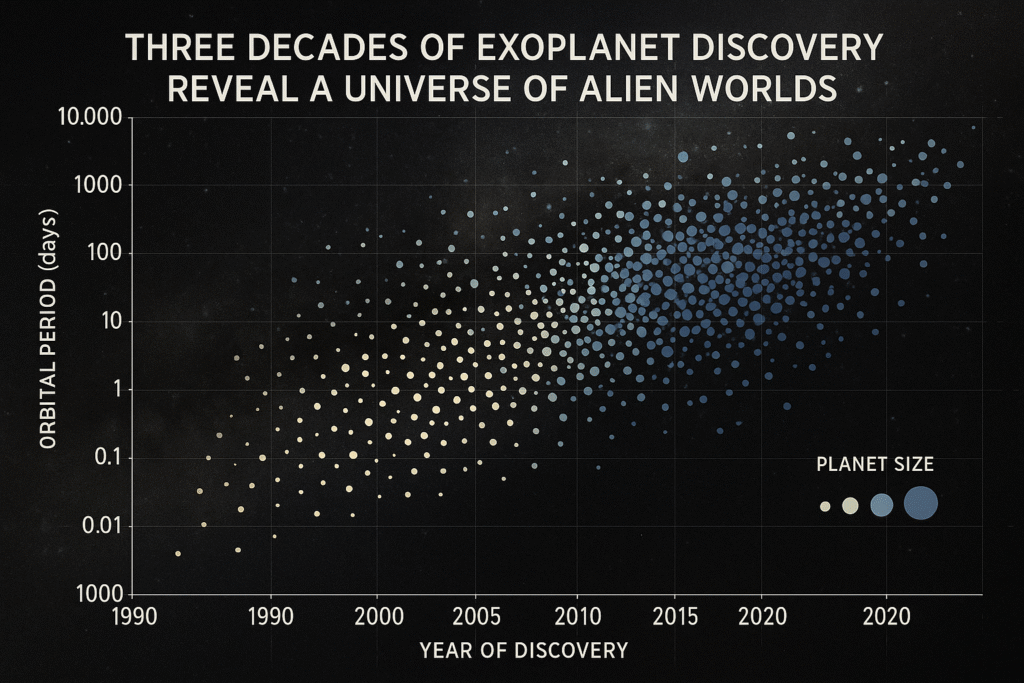By Harshit | 3 October 2025 | Pasadena, USA | 09:30 EDT
Thirty years ago, two Swiss astronomers announced the first confirmed detection of a planet orbiting a Sun-like star, 51 Pegasi, marking the beginning of modern exoplanetary science. The discovery, published in Nature, laid the groundwork for decades of exploration and fundamentally reshaped humanity’s understanding of planetary systems beyond the Solar System.
Since that initial detection, astronomers have catalogued more than 6,000 confirmed exoplanets, with thousands of additional candidates under investigation. Key contributors to this rapid expansion have been NASA’s Kepler and Transiting Exoplanet Survey Satellite (TESS) missions, along with a variety of ground-based observatories. These findings reveal a diversity of planetary types and system architectures that challenge prior assumptions about planet formation.
Diversity in the Exoplanetary Population
Exoplanets display remarkable variation in size, composition, and orbital characteristics. “Hot Jupiters,” gas giants orbiting extremely close to their parent stars, include the very first planet discovered around 51 Pegasi. In contrast, smaller planets categorized as “super-Earths” and “mini-Neptunes” are now recognized as some of the most common types detected. Many systems contain multiple planets in tightly coordinated orbits, while some planets are unbound, roaming freely through the galaxy. Additionally, circumbinary planets orbiting two stars — reminiscent of the fictional Tatooine — demonstrate the complexity of planetary dynamics.
Jessie Christiansen, astronomer at the California Institute of Technology (Caltech), commented: “Each exoplanet is a whole brand-new world, challenging our understanding of what constitutes a typical planetary system.”
Proxima Centauri: A Neighbor with Habitability Potential
Among the most notable discoveries are the planets orbiting Proxima Centauri, the Sun’s closest stellar neighbor at 1.3 parsecs. Observations with the European Southern Observatory in Chile revealed the first Proxima planet in 2016. This exoplanet is likely Earth-sized and resides within the star’s habitable zone, the region where liquid water could exist on its surface. A second confirmed planet, slightly smaller than Earth, lies just outside the habitable zone.
The proximity of Proxima Centauri makes these planets prime candidates for future interstellar exploration. Jean Schneider of the Paris Observatory noted that efforts such as the Breakthrough Starshot initiative, although currently stalled, represent the first serious attempts to conceptualize a spacecraft capable of visiting these nearby worlds.
TRAPPIST-1: Multiple Earth-Sized Worlds
The TRAPPIST-1 system, located approximately 12 parsecs away in Aquarius, contains seven Earth-sized planets discovered between 2016 and 2017. Several of these planets lie within the star’s habitable zone, providing a natural laboratory to study planetary evolution under varying stellar conditions.
The James Webb Space Telescope (JWST) has been analyzing TRAPPIST-1 planets for atmospheric signatures, with early results indicating that some planets may lack substantial atmospheres. Nonetheless, observations of planet ‘e’ suggest that habitable conditions remain possible. Astronomers also note that, from the surface of one TRAPPIST-1 planet, the others would appear as prominent objects in the sky, offering a view unlike any found in our Solar System.
K2-138: Resonant Orbits and Formation Clues
The K2-138 system, located roughly 200 parsecs away, contains six planets discovered through citizen-science analysis of Kepler data. These planets exhibit 3:2 orbital resonances, meaning that the orbital period of one planet is exactly 1.5 times that of its neighbor. This orderly configuration contrasts with the chaotic orbital histories observed in many planetary systems, including the Solar System. Scientists believe such resonances preserve clues about the slow and gradual processes that shaped the system’s final architecture.
Christiansen emphasized the significance of these patterns: “Resonant chains like those in K2-138 provide rare insights into planetary formation and migration mechanisms that are otherwise erased in dynamically unstable systems.”
Conclusion
Three decades of exoplanet research have transformed our understanding of planetary systems, revealing an unexpected diversity in size, composition, and orbital dynamics. From the nearby potentially habitable worlds of Proxima Centauri to the tightly packed TRAPPIST-1 planets and the musically resonant K2-138 system, astronomers continue to expand the catalog of known exoplanets while uncovering the physical processes that govern their formation.
As detection techniques improve and telescopes such as JWST provide higher-resolution observations, the coming years are expected to yield new discoveries, deepening our understanding of planetary habitability, atmospheric composition, and the potential for life beyond Earth.







